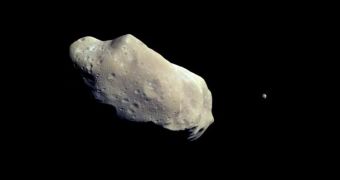According to a new theory, it could be that asteroid impacts that took place in our planet's distant past shot sprays of DNA material into deep space, which may have then made its way to worlds located around nearby stars.
In this manner, life may have traveled from our planet to other locations in the Sun's stellar neighborhood. Scientists already know that Earth and Mars exchanged meteorites and other materials in the past, and that lifeforms that evolved here may endure on the Red Planet even now.
Furthermore, studies have recently shown that the basic building blocks of life can endure asteroid impacts, survive for millions of years aboard space rocks, and then withstand the fiery conditions of entering another planet's atmosphere.
A group of astronomers is currently searching for extrasolar planets orbiting stars born from the same stellar nursery as the Sun. If these worlds exist, then they may have been seeded with life that originated here, long ago.
Astronomers suspect that the stellar nursery that gave birth to our Sun was disbanded about 3.5 billion years ago, around 1 billion years after our star formed. Before the sibling stars went their separate ways, they may have exchanged material between their respective systems, Space reports.
“The idea is if a planet has life, like Earth, and if you hit it with an asteroid, it will create debris, some of which will escape into space,” explains Mauri Valtonen, who holds an appointment as an astronomer at the University of Turku, in Finland.
“And if the debris is big enough, like 1 meter across, it can shield life inside from radiation, and that life can survive inside for millions of years until that debris lands somewhere. If it happens to land on a planet with suitable conditions, life can start there,” the expert goes on to say.
Though the idea may seem far-fetched at first, it does in fact make perfect sense. During the earliest days of the solar system, the orbits currently inhabited by the four rocky planets – Mercury, Venus, Earth and Mars – were battered by thousands upon thousands of impactors.
This period became known as the Late Heavy Bombardment. During this time, all the inner worlds were significantly bruised by asteroids and comets. Early bacteria and DNA sequences may have easily been carried into space aboard large chunks of debris.
“If we find an Earth-type planet, then it'd be a nice target for [a] new generation of detectors to point at the atmosphere of the planet. If there's a planet and it has signs of life, then we could say perhaps they are relatives in some sense,” Valtonen concludes.

 14 DAY TRIAL //
14 DAY TRIAL //